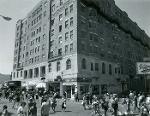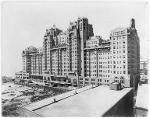Steve Rulli at the Mayflower
By Salena LeDonne
When Stockton State College initially opened its doors in fall 1971, the historic Mayflower hotel doubled as a space where students could live and courses could be taught. Since the Galloway campus in the Pine Barrens was still under construction during that first semester, the Atlantic City boardwalk became home to students from multiple walks of life, united by an eagerness to be a part of something new.
One of those students was Steve Rulli. In his story about the first cohort of Stockton students, Rulli tells a Mayflower era tale that captures the essence of our Stockton’s unabating spirit. Picture students joining a passing marching band and proceeding to play air instruments all the way down the boardwalk: this moment of freedom, fun, and togetherness set a precedent for the culture of Stockton.
Stockton State College Memories
By Steve Rulli
I started college on the GI Bill® after serving two years in the US Army during the Vietnam war. I spent my first two years at Burlington County Community College and then transferred to Stockton as a junior the very first year it opened. The college opened in the old Mayflower Hotel on Tennessee Avenue and the Boardwalk. The old hotel sat right on the boardwalk and a newer section, referred to as the motel, sat behind the hotel between Tennessee Ave. and St. James Place. The hotel was used for both classes and student housing while the motel section was strictly housing. I believe classes were only held in the hotel for the first semester. The new campus in Pomona opened in time for the second semester.
Since the college and the whole Stockton community were brand new, the first two weeks were slated for orientation for both students and faculty. For most of the students it was vacation time since all we had to do was monitor the classes we were interested in before signing up for a particular curriculum. During those first two weeks there was much free time to explore the city, enjoy the beach and boardwalk, and also to forge new relationships. I consider it to be one of the most interesting times of my life. The whole Stockton experience was at its very beginning.
I had a room to myself in the motel section of the complex. There were three floors to the motel and all the rooms had an outdoor balcony that faced St. James Place. On the street level directly across from the motel and up against the back of the boardwalk was a Tavern called McFeeleys. There was a staircase leading down from the boardwalk which ended at McFeely’s entrance. Many of the students spent time on the balconies on warm nights and you could carry on conversations with almost anyone on any level.
One warm autumn evening while the Shriners were in town for a convention held at the old Traymore Hotel their marching band came parading down the boardwalk and down the staircase onto St James Place stopping in front of McFeely’s tavern. Here they played a few tunes serenading the patrons of McFeeley’s and unknowingly all the resident motel students hanging out on the balcony behind them. When they finished we all gave them a loud applause much to their surprise. Someone in the band then commanded a “left face, forward march” and the band proceeded to march back onto the Boardwalk. Someone in the motel commanded, “Let’s join them” and about 30 of us ran down to the boardwalk and fell into formation right behind the band. The band was marching and playing in a double file and our group which was just as large as theirs were following suit only we were playing air instruments. Only a couple of the band members at the end of the line had any idea what was happening.
The band marched a couple of blocks down the boardwalk and right into the Traymore Hotel’s grand lobby which was filled with other conventioneers. Our air band was right in step and in a most jovial mood. Someone in the front of the band gave a “halt and right face” command and you would have thought we were an integral part of the parade with all of our new found precision marching skills. There we all silently stood facing the crowd in the lobby and it was an awkward silence. The marching band was slowly noticing the motley crew that came in behind them; the crowd in the lobby couldn’t take their eyes off us; and we could not be more proud of ourselves. The facial expressions that confronted us varied from complete outrage to utter amusement. Without missing a beat one of our group announced, “right face, forward march” and as if we had been marching all of our lives we proceeded out onto the boardwalk and back over to the Mayflower playing our air instruments to a lively marching tune. John Philip Sousa himself would have been proud of us.
I tell this story to friends every so often and what amazes me to this day is how perfectly coordinated our group was in such a spontaneous action. We were all new to each other and we instantly came together for a bit of outrageous fun. Incidentally the Traymore Hotel was one of the first to be imploded within months of our parade to make room for the onslaught of the casinos. The Shriners convention along with our air band was one of its last grand affairs. I consider that experience priceless.
* GI Bill® is a registered trademark of the U.S. Department of Veterans Affairs (VA). More information about education benefits offered by VA is available at the official U.S. government Web site at http://www.benefits.va.gov/gibill.






